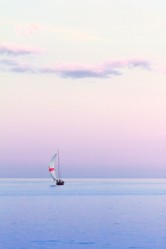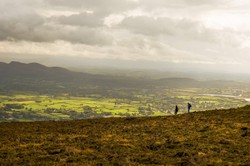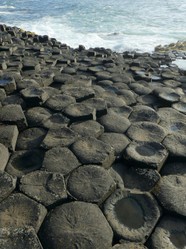After a brief stop in Islay where our somewhat tardy voyager sampled some of the delights of this isle renowned for its whisky, he set off on a potentially hazardous leg of the voyage because eschewing the windy west shores of Jura, which lie on the Minch, the waters between the Inner and Outer Hebrides, he took the narrow straits north past Jura and Mull. These took him near to the fearsome tide rips and swirling currents of the Bay of Corrievreckan. Here is a stretch of turbulent water,of overfalls where the sea turns chaotically choppy, and a whirlpool second in size to Norway's infamous maelstrom. Corrievreckan lies between Jura and Mull, and Marsden planned to avoid it, but some way from the bay he ran into an overfall.There was nothing to do but to sail on through a phenomenon that the admiralty pilot book describes as best avoided,but there were a few moments of terror when he thought that Corrievreckan's waters extended further out than he had thought. Then he passed through and the terror subsided.
He stopped at two more isles, Skye, where he moored at Portree and did some walking in the strange landscape of Quraing, with its jagged pinnacles; and then he moored for a final visit to Canna, where John Lorne Campbell had established a famous library of Gaelic culture. Marsden had visited Campbell's widow some years before and found her a wonderful woman, but now he came in her memory, for she was long departed. .
It was now time for the final dash to the Summer Isles. Marsden drove northward and the Summer Isles hove into view, but as he approached Tanera More, the largest of these isles and the only one with a usable harbour the seas were becoming mountainous and the seasons were turning against him.Landing would have been suicidal. But he knew that he had kept his word to his aunt. He had made the voyage. But there was an upside to his not landing, for the Summer Isles remained for him islands of the imagination. He does not describe the journey home, but I presume that he made his way home to Cornwall via the safer and shorter route down the Irish Sea, a route safer and shorter than the journey that he had taken.
This was an enjoyable book enhanced by the provision of two good, well-drawn maps that enable you to follow the route with ease.There are, however, few photographs. I commend this book to you readers in the confidence that you will enjoy it.
I am an Amazon Associate. I earn money from products advertised on this page











 Pilgrimage. A review26 days ago
Pilgrimage. A review26 days ago
 Leo the Fourteenthon 05/09/2025
Leo the Fourteenthon 05/09/2025
 The Melsonby Hoardon 03/25/2025
The Melsonby Hoardon 03/25/2025



Comments
None as dangerous as the three that you have mentioned, but Cape Wrath in North West Scotland is hard in bad conditions. The Goodwin Sands off Kent a mass of drowned lands onto which ships have been storm driven, and the coast of Cornwall are gangerous. The waters around the Isles of Scilly can be lethal in bad weather. The channel between Scotland and Orkney has a bad tidal race, and there is a whirlpool in certain tidal conditions in the bay of Corrievreckan in Scotland. It is said to be second only to the Maelstrom.
This month a woman became the first American woman to complete a non-stop, round-the-world boat race.
That race mandated rounding the challenging three capes Horn, Leeuwin and Cape of Good Hope.
Is there any part around the British Isles/United Kingdom that proves dangerously challenging for racers and sailors?
No. He thought only in terms of sailors.
The last sentence in the fifth paragraph to the first subheading, The beginning, considers that " I am reminded of Nicholas Monsarrat's novel, the Cruel Sea, where he says that the only enemy is the sea, for it is insensitive to human pain and death."
Does Monsarrat consider the sea insensitive to the challenges for and the dangers to water-world animals and plants?
I do not know of anyone else who has taken that particular route from Cornwall to the Summer Isles via the West of Ireland on a yacht.
I have always wondered how travelers undertake lone journeys, why don't they venture in an unknown territory with a friend or an expert. At the same time, I feel they are quite brave and the ruthless wanderlust make them do such things. The article especially becomes an enjoyable read as the author undertakes an unbeaten path to fulfill his promise to his Aunt.
Dear Mira,
The names that I have given are mainly in Celtic languages, still minority tongues in the British Isles.These are Welsh and Cornish, and the several kinds of Gaelic [the three dialects of Irish, Scottish and Manx.] Fair Isle, a lonely Scottish island, still uses occasional words of Norn, a Scandinavian language.
The names that I quoted were in Irish and Scots Gaelic. Ben [mountain] more [big] in Gaelic, which would be Pen Mawr [pronounced mower, with ow as in how] in Welsh. Aran may derive from ard [high/high place.] In Cornwall we have the Lizard Peninsula, which means Lis [place] ard [high.] Lis in Cornish is llys in Welsh. To pronounce ll in Welsh say cl. Portree means the port of the king. Corrie can be a circular head of a glaciated valley in Gaelic, but it would be cwm [coom] in Welsh and combe [pronounced coombe] in dialects of English with Celtic influence. A skellig is a jagged rock in the sea [skerry in western English dialects.] Don't worry much about English dialects, they are almost extinct, though they influence place names.
I cannot translate all place names, but Mayo,my wife's ancestral county, is in Gaelic Maigh Eo, the plain [maigh, pronounced may] eo, pronounced yo, [yew tree] hence the plains of the yew trees, which no longer grow there.
Uillean is pronounced illian.
Cornish is said to be related to Welsh, but I have noted affinities to Gaelic in it. For example, yr [er] is the Welsh for the,while an is Gaelic and Cornish for the.
As for the weather, Mira, the mists seem attractive, but at the moment the weather is not good, with some flooding and heavy rain.
I enjoyed the names in this piece. There's a sonority to them which makes me recall voices from various parts of the British Isles and from Ireland in documentaries on TV :) I hope that I'll be able to travel around the UK and Ireland in the future, as they all seem like enchanted places to me for some reason. Maybe the weather, with all those mists, has something to do with it :)
Marsden started his voyage from Fowey [pronounced Foy.] One of my earlier articles, Walking the South Cornish Coast, was set around Fowey.
Derdriu, South Cornwall is where the author lives, so that is where he started his voyage. The detour along the west coast of of Ireland was for interest, but you may be right that it is the route that the author's aunt would have chosen.But yes, South Cornwall seas are also dangerous.
Bodies and possessions of fallen climbers are recovered and handed over to the families of the deceased. Burial where they lie is not permitted.